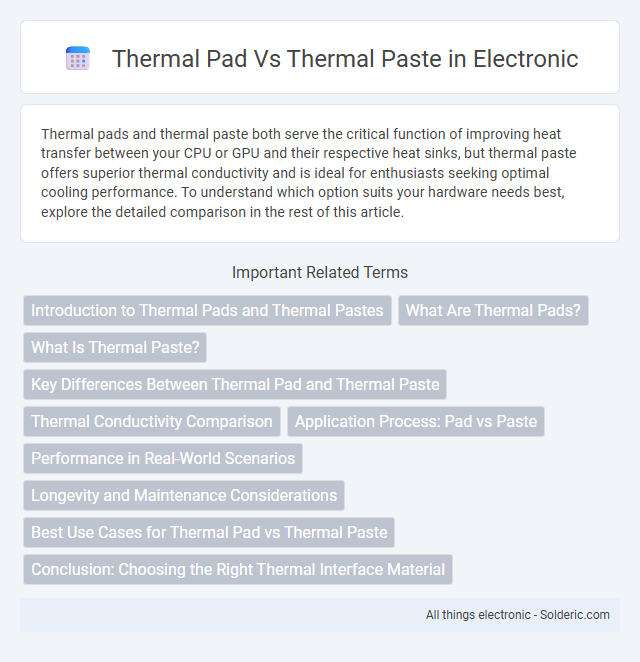Thermal pads and thermal paste both serve the critical function of improving heat transfer between your CPU or GPU and their respective heat sinks, but thermal paste offers superior thermal conductivity and is ideal for enthusiasts seeking optimal cooling performance. To understand which option suits your hardware needs best, explore the detailed comparison in the rest of this article.
Comparison Table
| Feature | Thermal Pad | Thermal Paste |
|---|---|---|
| Material | Synthetic rubber or silicone-based | Metal oxide or ceramic-based with a paste consistency |
| Thermal Conductivity | Moderate (1-7 W/mK) | High (4-13 W/mK) |
| Ease of Application | Pre-cut, easy to apply | Requires careful spreading for optimal performance |
| Reusability | Reusable, less messy | Usually single-use, can dry out over time |
| Longevity | Stable over time, minimal degradation | Can dry and crack, needs replacement periodically |
| Price | Moderate | Low to moderate |
| Ideal Use | Gap filling, easy installation, non-critical thermal needs | High-performance CPU/GPU cooling, critical thermal management |
Introduction to Thermal Pads and Thermal Pastes
Thermal pads and thermal pastes are essential materials used to improve heat transfer between electronic components and heat sinks, ensuring efficient cooling of CPUs, GPUs, and other hardware. Thermal pads are solid, silicone-based materials that offer easy installation and consistent thickness, while thermal pastes are viscous compounds designed to fill microscopic gaps for superior thermal conductivity. Choosing the right thermal interface material can significantly impact your device's thermal performance and longevity.
What Are Thermal Pads?
Thermal pads are solid, rubber-like materials designed to transfer heat between components such as CPUs, GPUs, and heat sinks, ensuring efficient thermal conductivity under varying pressure and surface conditions. Unlike thermal paste, thermal pads provide a cleaner application and maintain consistent thickness, making them ideal for filling larger gaps and irregular surface textures within electronic devices. You can rely on thermal pads for stable, long-lasting heat dissipation in environments where ease of installation and minimal mess are priorities.
What Is Thermal Paste?
Thermal paste is a thermally conductive compound applied between a CPU or GPU and its heatsink to enhance heat transfer by filling microscopic gaps. It improves your device's cooling efficiency by reducing thermal resistance and preventing overheating. Unlike thermal pads, thermal paste offers superior performance due to its ability to conform closely to surface irregularities.
Key Differences Between Thermal Pad and Thermal Paste
Thermal pads offer ease of installation and consistent thickness, providing reliable thermal conductivity with minimal mess, while thermal paste delivers superior heat transfer efficiency by filling microscopic gaps between surfaces. Thermal paste requires careful application and can dry out over time, whereas thermal pads are more durable and maintain performance without reapplication. Both materials serve to enhance heat dissipation in electronic devices, but the choice depends on the specific cooling requirements and maintenance preferences.
Thermal Conductivity Comparison
Thermal pads typically offer thermal conductivity ranging from 1 to 6 W/mK, while high-quality thermal paste can achieve conductivity levels above 8 W/mK, providing more efficient heat transfer between your CPU or GPU and the heatsink. The superior thermal conductivity of paste results in lower operating temperatures and improved overall device performance. Choosing the right interface depends on your need for optimal heat dissipation versus ease of application and maintenance.
Application Process: Pad vs Paste
Thermal pads offer a straightforward application process with minimal mess, as they are pre-cut, solid sheets that simply need to be placed between the CPU and heatsink. Thermal paste requires precise application and even spreading to avoid air bubbles and ensure optimal heat transfer, typically involving a small pea-sized amount applied to the CPU surface. While thermal pads allow for easier installation and reusability, thermal paste generally provides superior thermal conductivity when applied correctly.
Performance in Real-World Scenarios
Thermal paste generally provides superior thermal conductivity and better heat transfer between the CPU or GPU and the heatsink, resulting in lower operating temperatures during intensive tasks like gaming or video rendering. Thermal pads, while easier to apply and less messy, often have higher thermal resistance and are better suited for components with uneven surfaces or less critical cooling demands. In real-world scenarios, thermal paste is preferred for achieving optimal performance in overclocking and sustained heavy workloads, whereas thermal pads are commonly used for simpler, maintenance-friendly setups.
Longevity and Maintenance Considerations
Thermal pads typically offer longer longevity and require less frequent maintenance due to their solid form and resistance to drying out or degradation over time. Thermal paste, while providing superior thermal conductivity, tends to dry and degrade faster, necessitating periodic reapplication to maintain optimal performance. Your choice should consider how often you're willing to perform maintenance and the desired balance between durability and thermal efficiency.
Best Use Cases for Thermal Pad vs Thermal Paste
Thermal pads excel in ease of installation and consistent thickness, making them ideal for applications with uneven surfaces or components with varying heights, such as VRMs and memory chips. Thermal paste offers superior thermal conductivity and is best suited for CPU and GPU cooling solutions where maximizing heat transfer between the heatsink and processor is critical. Choosing the right thermal interface material depends on device design requirements and thermal performance needs.
Conclusion: Choosing the Right Thermal Interface Material
Selecting the appropriate thermal interface material depends on the specific application and thermal management requirements. Thermal paste offers superior thermal conductivity and is ideal for high-performance CPUs and GPUs due to its ability to fill microscopic gaps between surfaces. Thermal pads provide easier installation and consistent thickness, making them suitable for less demanding or space-constrained environments where convenience and reliability are priorities.
Thermal pad vs Thermal paste Infographic

 solderic.com
solderic.com